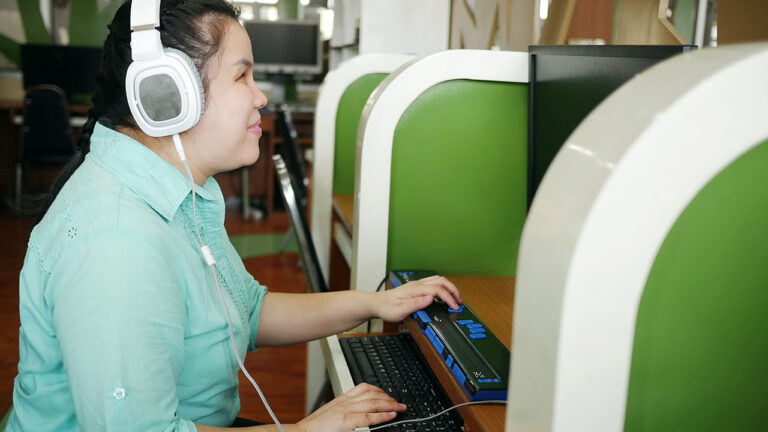The country is now several months into the coronavirus pandemic and employees with visual impairments, like many others, are still working from home. Initially, the thought was temporary but now working from home seems more long term and the new challenge is keeping home and work space separated. It is important to set up a work space in the home to achieve balance, productivity and efficiency. Here are some ways to successfully separate your home and work space while working remotely.
Mental impact of working remotely
Before even getting into the physicality of working from home, understand the mental impact this change will make in your life. You are now combining your job and home into one location. Perhaps you like, or even love, your job but doing it from home day after day will take a toll on your mental health, especially if you don’t find balance and separation. To be successful, establish strong boundaries between work and home. This includes taking routine breaks, setting a dedicated work schedule and communicating with your family and employer.
Assess your work space
Think about what your physical needs are to do your job effectively. Consider your technology such as a desktop, laptop or tablet. Also consider a printer, fax machine or file cabinet. If you are a person who is vision impaired, then consider a CCTV to read items in large print, hand-held magnifiers and other vision impaired aids. And if you are blind, consider a braille note taking device. Think about all of these items taking space and the best place in your home for them. Be sure that you have communicated in advance with your employer about any assistive technology needs you have.
Next, consider office furniture. It is not necessary to purchase something fancy or the latest design but something that is durable, functional and comfortable. Consider an office table that is large enough to hold your computer equipment, office supplies and other work items. Think about a good quality chair that will support your back, arms and legs.
Design your workspace or home office
In order to be in the right frame of mind to work and to boost productivity, design the work area. If you have a room to convert to a home office, set it up as such and decorate accordingly. If you need to take room in the corner of a living space use furniture like a large sofa to physically block it off. Try and duplicate your home work space like the one back in the office. Include favorite desk toys and office supplies. Incorporate proper lighting for your space. If overhead lights are not efficient, add a table lamp for extra lighting. Consider a separate work phone or phone line. This will help prevent business calls being answered during non-work hours. Also adjust phone notifications to alleviate distractions and disturbances.
Create a fake commute
People with visual impairments typically take public transportation to work resulting in long travel times but that ends when working from home. Now, a quick couple of steps across the hall or to another room in the house is all it takes to travel to work. This short shuttle can make separation of home from work hard to distinguish. So create a phony commute. Spend time at the beginning and end of the work day reading an audiobook or listening to a podcast. Use this time for light exercise or a walk around the block. Check the time that you would have been traveling to work and instead incorporate these activities. This can help trick your brain that you are transitioning from home to work.
Dress for work success
It can be appealing to wear an outfit of sweatpants and pajamas instead of business attire when working from home for an extended time. Yet there is something about adhering to an office dress code to maintain normalcy, efficiency and good mental health. Additionally, getting up and properly dressing will assist in separating home from work indicating a shift in the day. To prepare and save time, organize your closet and mark or label clothing for an easier morning routine.
Be patient with yourself and others
At the end of the day, working remotely has its challenges because you are combining home and work in the same space, especially if you are vision impaired. Be patient with yourself and prioritize your personal life and wellbeing. Understand that these are unprecedented times and your work environment, schedule and routine has changed. Be flexible and relax into your work day. Understand that you might have to focus more on home than usual, especially if you are parenting or caregiving while also trying to work. Discuss with coworkers and management how your daily life has changed, how you need work to shift as a result and to find support. It is admirable to soldier on with business as usual but a pandemic is happening. So give yourself permission to take care of yourself more than usual.



